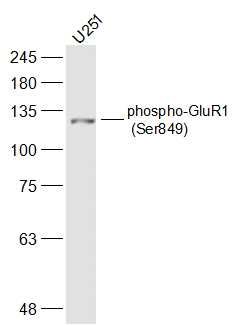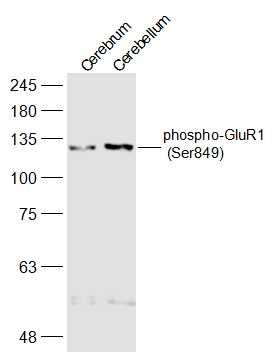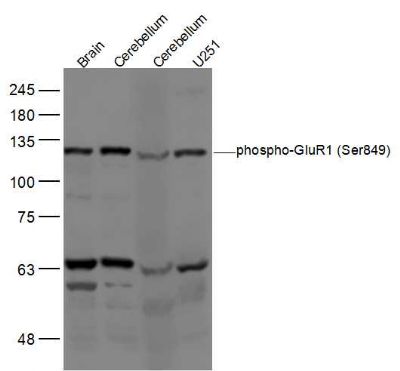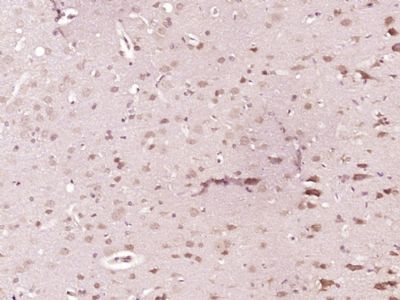| 中文名稱(chēng) | 磷酸化谷氨酸受體1抗體 |
| 別 名 | GluR1 (phospho Ser849); GluR1 (phospho S849); p- GluR1(Ser849); p- GluR1(S849); GLUR 1; GLUR A; AMPA 1; AMPA selective glutamate receptor 1; GLUH 1; GLUH1; GluR K1; GluR-1; GluR-A; GluR-K1; GLUR1; GLURA ; GluRK1; Glutamate receptor 1; Glutamate receptor ionotropic AMPA 1; Gria 1; Gria1 ; Gria1; HBGR1; MGC133252. |
| 產(chǎn)品類(lèi)型 | 磷酸化抗體 |
| 研究領(lǐng)域 | 腫瘤 細(xì)胞生物 免疫學(xué) 神經(jīng)生物學(xué) 信號(hào)轉(zhuǎn)導(dǎo) 細(xì)胞凋亡 轉(zhuǎn)錄調(diào)節(jié)因子 |
| 抗體來(lái)源 | Rabbit |
| 克隆類(lèi)型 | Polyclonal |
| 交叉反應(yīng) | Human, Mouse, Rat, (predicted: Chicken, Dog, Pig, Cow, Horse, Sheep, ) |
| 產(chǎn)品應(yīng)用 | WB=1:500-2000 ELISA=1:500-1000 IHC-P=1:100-500 IHC-F=1:100-500 IF=1:50-200 (石蠟切片需做抗原修復(fù)) not yet tested in other applications. optimal dilutions/concentrations should be determined by the end user. |
| 分 子 量 | 98kDa |
| 細(xì)胞定位 | 細(xì)胞漿 細(xì)胞膜 細(xì)胞外基質(zhì) |
| 性 狀 | Liquid |
| 濃 度 | 1mg/ml |
| 免 疫 原 | KLH conjugated synthesised phosphopeptide derived from human GluR1 around the phosphorylation site of Ser849:QQ(p-S)IN |
| 亞 型 | IgG |
| 純化方法 | affinity purified by Protein A |
| 儲(chǔ) 存 液 | 0.01M TBS(pH7.4) with 1% BSA, 0.03% Proclin300 and 50% Glycerol. |
| 保存條件 | Shipped at 4℃. Store at -20 °C for one year. Avoid repeated freeze/thaw cycles. |
| PubMed | PubMed |
| 產(chǎn)品介紹 | Glutamate receptors are the predominant excitatory neurotransmitter receptors in the mammalian brain and are activated in a variety of normal neurophysiologic processes. These receptors are heteromeric protein complexes with multiple subunits, each possessing transmembrane regions, and all arranged to form a ligand-gated ion channel. The classification of glutamate receptors is based on their activation by different pharmacologic agonists. This gene belongs to a family of alpha-amino-3-hydroxy-5-methyl-4-isoxazole propionate (AMPA) receptors. Alternatively spliced transcript variants encoding different isoforms have been found for this gene. [provided by RefSeq, Jul 2008]. Function: Ionotropic glutamate receptor. L-glutamate acts as an excitatory neurotransmitter at many synapses in the central nervous system. Binding of the excitatory neurotransmitter L-glutamate induces a conformation change, leading to the opening of the cation channel, and thereby converts the chemical signal to an electrical impulse. The receptor then desensitizes rapidly and enters a transient inactive state, characterized by the presence of bound agonist. In the presence of CACNG4 or CACNG7 or CACNG8, shows resensitization which is characterized by a delayed accumulation of current flux upon continued application of glutamate. Subunit: Homotetramer or heterotetramer of pore-forming glutamate receptor subunits. Tetramers may be formed by the dimerization of dimers. Interacts with DLG1 via its C-terminus. Interacts with SYNDIG1 and GRIA2. Interacts with LRFN. Interacts with HIP1 and RASGRF2. Found in a complex with GRIA2, GRIA3, GRIA4, CNIH2, CNIH3, CACNG2, CACNG3, CACNG4, CACNG5, CACNG7 and CACNG8. Interacts with CACNG5. Interacts with CNIH2 and CACNG2. Subcellular Location: Cell membrane; Multi-pass membrane protein. Endoplasmic reticulum membrane; Multi-pass membrane protein. Cell junction, synapse, postsynaptic cell membrane; Multi-pass membrane protein. Cell junction, synapse, postsynaptic cell membrane, postsynaptic density. Cell projection, dendrit. Cell projection, dendritic spine. Note=Interaction with CACNG2, CNIH2 and CNIH3 promotes cell surface expression. Tissue Specificity: Widely expressed in brain. Post-translational modifications: Palmitoylated. Depalmitoylated upon glutamate stimulation. Cys-603 palmitoylation leads to Golgi retention and decreased cell surface expression. In contrast, Cys-829 palmitoylation does not affect cell surface expression but regulates stimulation-dependent endocytosis. Similarity: Belongs to the glutamate-gated ion channel (TC 1.A.10.1) family. GRIA1 subfamily. SWISS: P42261 Gene ID: 2890 Database links: Entrez Gene: 2890 Human Entrez Gene: 14799 Mouse Entrez Gene: 50592 Rat Omim: 138248 Human SwissProt: P42261 Human SwissProt: P23818 Mouse SwissProt: P19490 Rat Unigene: 519693 Human Unigene: 4920 Mouse Unigene: 29971 Rat Important Note: This product as supplied is intended for research use only, not for use in human, therapeutic or diagnostic applications. NMDAR1又稱(chēng)GluR1 (Glutamate Receptor 1)近年實(shí)驗(yàn)研究發(fā)現(xiàn),許多NMDAR拮抗藥均具有鎮(zhèn)痛活性,表明NMDAR在痛覺(jué)傳遞中具有重要作用,這為新型鎮(zhèn)痛藥的研究開(kāi)發(fā)提供了新的作用靶點(diǎn)。 |
| 產(chǎn)品圖片 |  Sample: Sample:Cerebrum (Mouse) Lysate at 40 ug Cerebellum (Mouse) Lysate at 40 ug U251 (Human) Lysate at 30 ug Primary: Anti-phospho-GluR1 (Ser849) (bs-8446R) at 1/500 dilution Secondary: IRDye800CW Goat Anti-Rabbit IgG at 1/20000 dilution Predicted band size: 98 kD Observed band size: 128 kD  Sample: Sample:Cerebrum (Mouse) Lysate at 40 ug Cerebellum (Mouse) Lysate at 40 ug Primary: Anti-phospho-GluR1 (Ser849) (bs-8446R) at 1/500 dilution Secondary: IRDye800CW Goat Anti-Rabbit IgG at 1/20000 dilution Predicted band size: 98 kD Observed band size: 128 kD  Sample: Sample:Brain (Mouse) Lysate at 40 ug Cerebellum (Mouse) Lysate at 40 ug Cerebellum (Rat) Lysate at 40 ug U251 (Human) Lysate at 30 ug Primary: Anti- phospho-GluR1 (Ser849) (bs-8446R) at 1/500 dilution Secondary: IRDye800CW Goat Anti-Rabbit IgG at 1/20000 dilution Predicted band size: 98 kD Observed band size: 130 kD  Paraformaldehyde-fixed, paraffin embedded (Rat brain); Antigen retrieval by boiling in sodium citrate buffer (pH6.0) for 15min; Block endogenous peroxidase by 3% hydrogen peroxide for 20 minutes; Blocking buffer (normal goat serum) at 37°C for 30min; Antibody incubation with (phospho-GluR1 (Ser849)) Polyclonal Antibody, Unconjugated (bs-8446R) at 1:400 overnight at 4°C, followed by operating according to SP Kit(Rabbit) (sp-0023) instructionsand DAB staining. Paraformaldehyde-fixed, paraffin embedded (Rat brain); Antigen retrieval by boiling in sodium citrate buffer (pH6.0) for 15min; Block endogenous peroxidase by 3% hydrogen peroxide for 20 minutes; Blocking buffer (normal goat serum) at 37°C for 30min; Antibody incubation with (phospho-GluR1 (Ser849)) Polyclonal Antibody, Unconjugated (bs-8446R) at 1:400 overnight at 4°C, followed by operating according to SP Kit(Rabbit) (sp-0023) instructionsand DAB staining. |
我要詢(xún)價(jià)
*聯(lián)系方式:
(可以是QQ、MSN、電子郵箱、電話等,您的聯(lián)系方式不會(huì)被公開(kāi))
*內(nèi)容:









